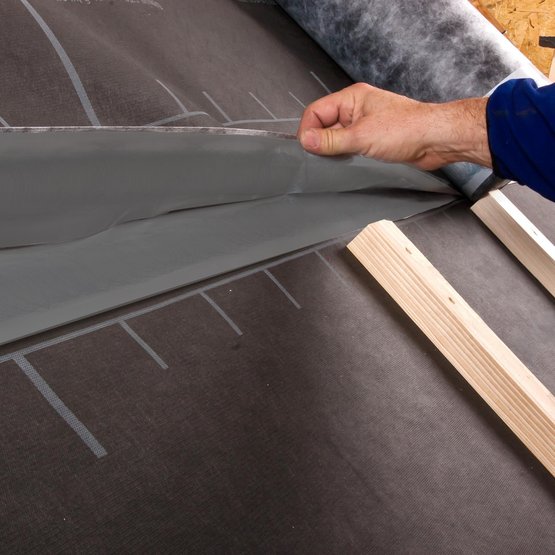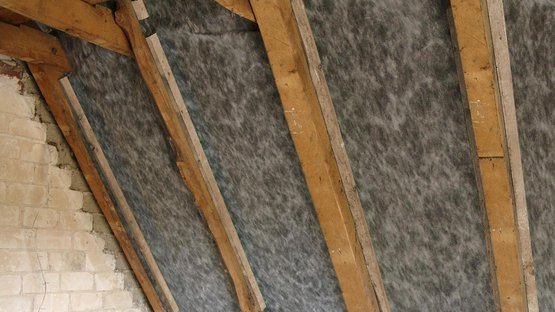Reinforced, high tear-resistance roofing underlay, with self-adhesive strips
Advantages
- Excellent occupational safety, even for large-sized roof tiles, in accordance with DIN 4426
- Flexible planning of construction schedules thanks to 4 months of outdoor exposure
- Well-protected building structures: highly diffusion-open and maximum protection against driving rain and hail
- Dry building structures: pore-free TEEE functional film actively transports moisture to the outside
- Long-term protection thanks to the high resistance to ageing and heat of the TEEE functional film
- Provides protection during the construction period: suitable as a temporary covering
- Quick and reliable adhesion thanks to the integrated ‘connect’ self-adhesive strips on the long edges of the membrane
Areas of application
Diffusion-open roofing underlay for installation hanging freely across all the rafters or else over roof sheathing, MDF and wood-fibre underlay panels, and over all thermal insulation materials, including blown-in insulation materials. Fulfils the requirements of DIN 4426, Clause 5.2 “Devices to protect against falls on roofs” (Table 2 – Tensile strength for sarking membranes as per DIN EN 13859-1, 5.2.6, such as ≥ 450 N/5 cm) for large distances between roof battens due to large-sized roof tiles.
Planning and construction guidelines
Areas of application
The membranes in the SOLITEX MENTO series can be used as roofing underlay membranes and as temporary coverings. They stop cold external air from flowing through the building structure and ensure that the thermal insulation works in an optimal manner.
- For ventilated pitched roofs – see applicable national regulations for permissible roof pitches
- Freely hanging or else installed directly onto even subsurfaces such as all mat or panel-shaped thermal insulation materials, wood-based panels or solid-wood boarding, for example
- Suitable as a temporary covering during the construction phase in accordance with the applicable national regulations
- If blown-in insulation materials are used, use of a reinforced SOLITEX roofing underlay is recommended
Use as a temporary covering
SOLITEX MENTO membranes can be used as temporary covering for up to 6 months to protect the building structure during the construction phase. The minimum pitch for the use of SOLITEX MENTO membranes is stipulated by national regulations in certain cases. For further information, please contact the pro clima partner in the country where the membranes are to be used. System adhesive tapes and adhesives should be used to stick overlaps and joints.
- The ‘connect‘ variants have two self-adhesive strips for reliable external sealing.
Dark marks may form on the membrane as a result of rainwater. These have no influence on the high level of watertightness and the effectiveness of the interior membrane.
Retrofitting roofing underlay
If there was previously no roofing underlay, SOLITEX roofing underlays can be retrofitted from the inside. Roof structures without underlay and thus without a counter-batten plane are often encountered on existing buildings. If insulation is to be fitted on these structures, it is recommended to first retrofit an exterior insulation-protection layer to improve the reliability of the structure.
No rear ventilation of the insulation layer is necessary
Roofing underlay membranes make rear ventilation of thermal insulation materials unnecessary. pro clima SOLITEX roofing underlay membranes can be installed directly onto the thermal insulation in all cases, i.e. the insulation material can fill the full depth of the rafters.
In the case of non-insulated attics, it is advantageous to provide hip and ridge ventilation in order to ventilate the attic space. Complicated and frequently ineffective ventilation features on the eaves, ridge, valley, hip and roof fittings are thus not necessary.
Increased indoor humidity
These highly permeable membranes allow moisture to dry out of the structure to the outside more easily and more quickly. This is advantageous both during the construction phase and during normal use (if moisture contained in the indoor air penetrates into the structure by diffusion or convection).
As a rule, moisture that arises due to construction work should be able to escape the building structure quickly by ventilation through open windows. Dryers can help to speed up the drying process in wintertime. This helps to avoid permanently high levels of relative humidity.
No ‘tent effect’
Pore-free SOLITEX membranes offer particularly good watertightness against driving rain. The membrane can be installed over the surface of insulation materials or onto the roof sheathing. A tent effect is reliably prevented by the monolithic functional film and the multi-layer structure. The term ‘tent effect’ describes the phenomenon whereby waterproof tent sheets allow large amounts of moisture into tents at points where they are in contact with inside objects.
Rainproof roofing underlays
These membranes may be used as temporary coverings and additional rain-protection measures, in accordance with the locally applicable regulations.
Approval and composition
The special membranes in the SOLITEX roofing underlay series are made of a thermoplastic elastomer ether-ester; the protective and covering fleeces are made of polypropylene.
All SOLITEX membranes have been tested in accordance with the requirements of EN 13859-1. They have the CE label.
Technical support
If you have questions on applications, please contact pro clima Technical Support.
pro clima on the outside ... and it's a wrap!
Weathertightness with pro clima
Find out more about pro clima's system solutions and products for sealing your building envelope on the outside - with roofing underlay membranes, breather membranes for facades, protective membranes for timber structures during the construction phase, and a full range of sealing tapes, sealants and accessories.


























